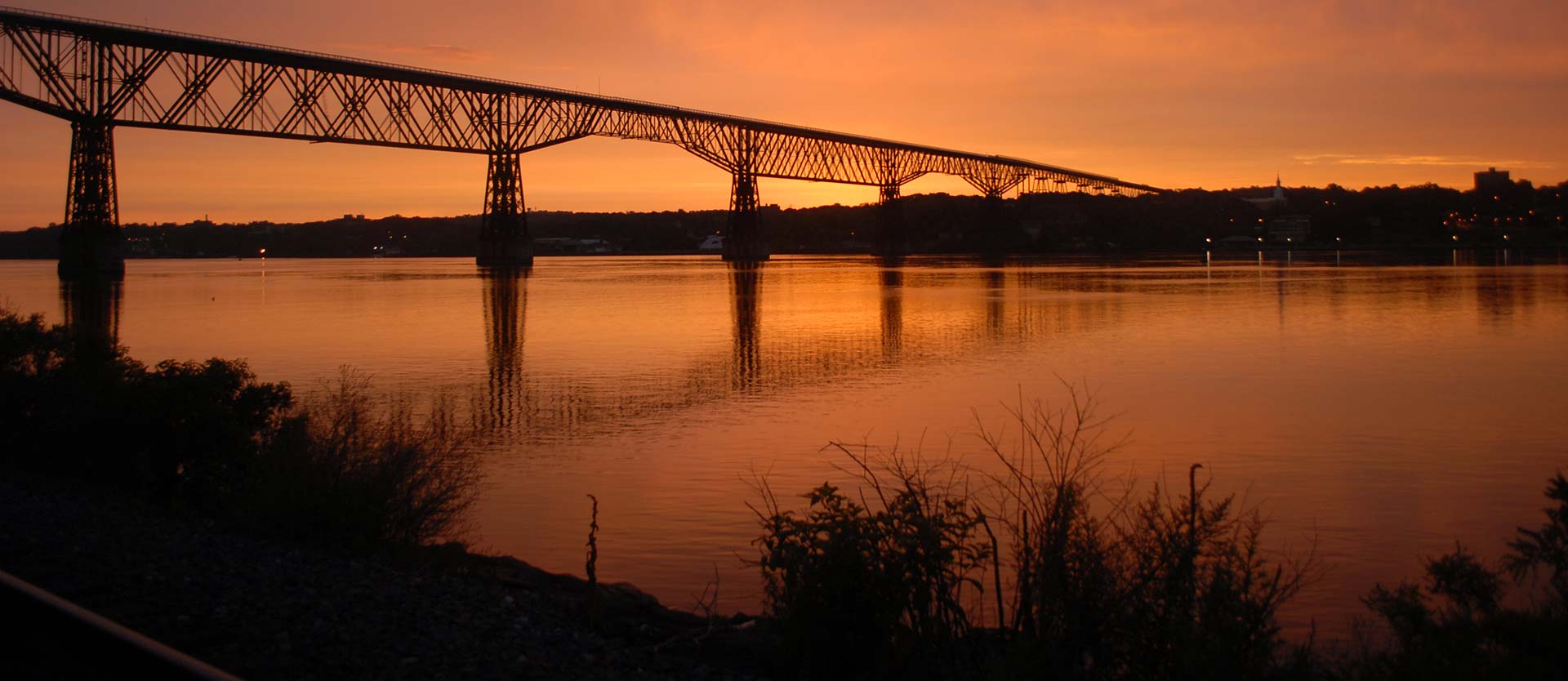Walkway History
Walkway Over the Hudson (formerly known as the Poughkeepsie Bridge, Poughkeepsie Railroad Bridge, Poughkeepsie–Highland Railroad Bridge, and High Bridge) is a steel cantilever bridge spanning the Hudson River between Poughkeepsie, New York, on the east bank and Highland, New York, on the west bank. Built as a double track railroad bridge, it was completed on January 1, 1889, and formed part of the Maybrook Railroad Line of the New York, New Haven and Hartford Railroad.
It was taken out of service on May 8, 1974, after it was damaged by fire. It was listed on the National Register of Historic Places in 1979, and its entry updated in 2008. The bridge was designated as a National Historic Civil Engineering Landmark by the American Society of Civil Engineers in 2009.
It was reopened on October 3, 2009, as a pedestrian walkway as part of the new Walkway Over the Hudson State Historic Park. The New York State Bridge Authority owns and is charged with maintaining the bridge structure (as directed by the Governor and Legislature in July, 2010). The park is operated by the New York State Office of Parks, Recreation and Historic Preservation. In 2017, the walkway hosted 593,868 visitors. The park connects the Hudson Valley Rail Trail in Highland to the William R. Steinhaus Dutchess Rail Trail, and forms part of the Empire State Trail.
Read the complete history of the bridge, it's construction, railroad bridge past, dormancy, and rebirth as Walkway Over the Hudson via Wikipedia.
History of the Walkway (In Two Minutes)
A short film produced by Bob Kaminsky
Fast Facts
- The bridge now known as the Walkway Over the Hudson opened in 1889 as the Poughkeepsie-Highland Railroad Bridge to transport western raw materials to eastern industrial centers. Rosendale cement was used in the original construction of the piers. At the time of its opening, it was the longest bridge in the world.
- In addition to freight trains, the bridge hosted passenger trains connecting Boston, New York, Harrisburg, Philadelphia, Baltimore and Washington as early as 1890. Trolley cars termed “rapid transit”, were modified to run on both trolley and railroad tracks and served tourists, students and shoppers (from New Paltz to Lucky Platt’s). Special West Point Football trains ran from 1921-1930. Circus trains, milk trains, trains for hogs and cattle – the uses were varied and the impact was huge. At its peak as many as 3,500 rail cars crossed the bridge each day.
- There were two sets of tracks until 1918, when gauntlet track, also called interleaved track, was installed to handle the weight of heavier locomotives. It was removed in 1958.
- During World War II the bridge was painted black to make it less visible in the event of an attack. Painting continued until the 1960’s. The high quality of the steel used in the original construction does not need to be painted. Metal experts during reconstruction stated that the absence of paint in fact helped keep the steel in the good condition it is in today.
- The fire that destroyed the tracks in 1974 was probably started by a spark from a train’s brakes. From Carleton Mabee's Bridging the Hudson, page 247. “An hour after a Penn Central train with 100 cars crossed the bridge on May 8, 1974, a thick cloud of black smoke hung over the bridge. Wooden ties were smoldering and wooden walkways were burning, fanned by a moderate breeze. Because Penn Central had no guards or maintenance men on the bridge at the time, the fire was not quickly reported. When firemen arrived at the site, they found they could not easily pump water up to the top of such a high bridge. When they tried turning on the water to flow into the steel pipe which ran the length of the bridge, a line meant to help fight fires, they found that because it had not been drained the previous winter, it had burst at several points – Penn Central had known it but had not repaired it.”
- Rebuilt and re-opened in October 2009 as the Walkway Over the Hudson State Historic Park, thanks to the efforts of a dedicated friends group, the Dyson Foundation, many donors and New York State.
- At 212 feet above the Hudson River, this 1.28 mile linear park boasts scenic views north to the Catskills and south to the Hudson Highlands.
- The Walkway is part of the Hudson Valley Rail Trail Network, and was inducted into the Rail-Trail Hall of Fame in 2016. It connects Ulster County's Hudson Valley Rail Trail to the William R. Steinhaus Dutchess Rail Trail.
- The ADA-compliant 21-story glass elevator provides seasonal access from Poughkeepsie's waterfront at Upper Landing Park, a short walk from the Metro North train station.
- The Walkway welcomes more than 600,000 visitors annually from all over the world who enjoy walking, cycling and running amidst its scenic beauty.
- Today, the Walkway is operated and owned by NYS Office of Parks, Recreation and Historic Preservation and the NYS Bridge Authority. It is open year-round, offering programs, events and tours made possible through membership and donations to the Walkway organization.
Poughkeepsie Railroad Bridge Past And Present
A 14-minute documentary by Tom Illich






